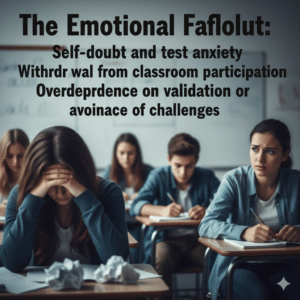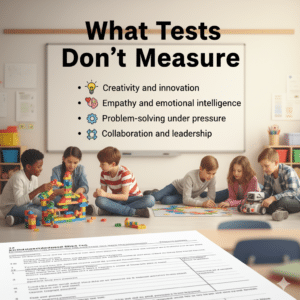We’re told that school tests measure how well a student understands what’s been taught. But here’s the problem: Testing Secrets Schools rarely admit how unfair, biased, and outdated those systems actually are.
Behind every “standardized” test is a design that fits only a narrow range of minds and backgrounds. The rest, including special needs students, neurodiverse learners, and many Black children, are left struggling to prove their worth in a game rigged from the start.
Let’s pull back the curtain on what schools don’t tell you about testing and why it’s time to rethink what fairness really means in education.
Schools love to call their exams “standardized” as if that makes them fair. But fairness doesn’t mean sameness. Most tests are designed and scored by people from similar cultural and linguistic backgrounds.
This creates educational bias that’s invisible to most teachers but devastating for students who don’t fit the “standard mold.” For example, bias in standardized tests often comes through in reading passages, word choices, or even examples that favor one cultural experience over another.
What’s sold as “fair testing” is actually one-size-fits-all education—and that size doesn’t fit everyone.
When standardized tests were created in the early 1900s, inclusivity wasn’t even a concept. They were designed for uniformity and ranking — not understanding or accessibility.
So when school testing for special needs students happens today, we’re using an outdated system on a diverse generation. Students with learning disabilities — like dyslexia or ADHD — are still forced into tests that punish them for their differences.
It’s not equality if the system ignores the starting line.

Grades were meant to show mastery not worth. But in reality, grades often reflect a child’s environment, test anxiety, or access to support systems.
A neurodiverse learner might see complex patterns that others miss but lose marks for “not following the format.” A child with autism might struggle with abstract phrasing, even when they fully understand the concept.
So when schools say, “The data doesn’t lie,” remember it’s only measuring what the system values, not what students truly know.

Culture shows up everywhere — even in test questions. Many reading and comprehension tests use cultural references that are completely unfamiliar to certain students.
A test question about “summer camps” or “snowball fights” may seem normal to one student but meaningless to another who’s never experienced those things.
This leads to cultural bias in education, where test results reflect exposure, not ability.
In short:

Many schools publicly champion inclusion — but behind the scenes, they fail to deliver it. Parents often don’t know that testing accommodations rights are legally protected under disability and education laws.
| Type of Accommodation | Who It Helps | Purpose |
| Extra Time | Students with ADHD, dyslexia | Reduces time pressure and improves comprehension |
| Quiet Rooms | Students with autism or anxiety | Lowers sensory stress and distractions |
| Simplified Instructions | Students with processing disorders | Ensures understanding without changing difficulty |
These aren’t special favors; they’re basic fairness tools. But many families, especially those from marginalized backgrounds, never hear about them. That silence keeps unfair testing practices alive.
Here’s one of the dirtiest Testing Secrets Schools never admit: test scores aren’t just about students — they’re about funding and reputation.
Many districts rely on performance averages to secure grants or maintain rankings. So when certain students are predicted to “drag down the average,” they’re quietly discouraged from testing.
It’s not just unethical — it’s educational manipulation. The system protects its image at the expense of its most vulnerable learners.

Being told you’re “underperforming” when you’ve tried your best takes a psychological toll — especially for Black students and special education students.
Every low-grade chip away at confidence. Every red mark reinforces the idea that they’re “not smart enough.” This creates a pattern of academic trauma that can last years.
If education is supposed to build children up, testing bias does the opposite. It erodes self-worth under the guise of “accountability.”

Most teachers aren’t villains. They’re working within systems that were biased long before they started teaching. But structural discrimination in testing still hurts students, even without intent.
This is how systemic racism in schools hides in plain sight: under layers of “neutral policy.”
Here’s what standardized tests can’t measure but should:
Many neurodiverse learners excel in these areas. Many Black students bring deep cultural intelligence, adaptability, and resilience. But because these traits don’t fit the test format, they’re ignored.
And that’s the biggest failure of all: confusing compliance with intelligence.

Here’s the hopeful part — change is possible. Around the world, schools are moving toward inclusive education reform, where assessment is flexible and equity is the goal.
According to Understood.org, when students are given equitable accommodations and teachers adopt flexible teaching methods, classroom engagement rises and academic confidence improves dramatically.
Educational justice isn’t about making tests easier — it’s about making them fair for everyone.
The most common ones are cultural bias, racial bias, and bias against neurodiverse learners. These often appear in question design, time limits, and grading expectations.
They’re a legal right under laws like IDEA (Individuals with Disabilities Education Act). Every student has the right to be assessed fairly based on their learning needs.
They matter less than before. Many universities and employers are shifting toward holistic evaluations that consider creativity, problem-solving, and real-world skills — the things tests can’t measure.
At the end of the day, Testing Secrets Schools Don’t Tell You exposes a deeper truth: the system measures conformity, not brilliance.
When special children and Black students fall through the cracks, it’s not because they’re incapable — it’s because they’re being tested by outdated standards.
Fairness doesn’t mean treating everyone the same. It means giving each child what they need to thrive. Until schools measure potential instead of performance under pressure, we’re not testing intelligence—we’re testing privilege.
It’s time to rebuild education from the ground up, with inclusion as the foundation, not an afterthought.